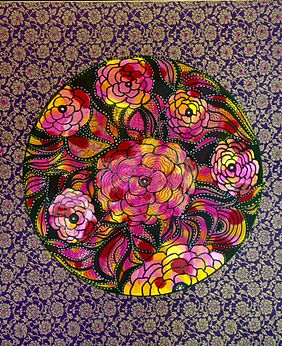Mandalas

The Mandala of Gratitude in thanksgiving for my many blessings. Watercolor and Ink on paper. Completed 2017. Artist's Collection.
A circle with no beginning and no end.
A symbol of wholeness that’s been used for healing and meditation, since ancient times, the word Mandala comes from the Sanskrit, and means “a sacred circle of life and all that it contains.” However, if one was to probe deeper, one would discover that this word, mandala, is derived from the root word ‘manda’ which means ‘essence, energy and spirit.’ And when one adds the suffix ‘la’, to any Sanskrit word, one makes it a ‘container’ or a vessel. Thus, mandala can also mean a container for essence, energy or spirit.
If one was a tad observant, one will find mandalas abound all over the place, and feature a great deal in our daily lives. Examples of mandalas are the globe, the sun, the moon, a clock or watch face, flowers aplenty, starfishes, flatware for dinning, spider webs, snowflakes, wheels, a compass, a balloon, a ring, the iris of the human eye, cells, atoms, the eight-pointed feng shui ‘pa kua’ symbol, the Chinese yin yang symbol, the Tibetan kalacharkra, and indeed the list goes on and on.
Stonehenge built by the Druids is also a striking example of the mandala, as is the medicine wheel of the native American Indians. Think of those beautiful stained glass windows in old Gothic churches in Europe, such as the famous rose windows in Notre Dame, and one will realise that truly we are surrounded by mandalas.
Making mandalas offers inroads into oneself, and offers a form of healing. Carl Jung believed in the power of mandalas, and was noted to draw one almost daily. Jung maintained that “we frame our expressions” within a circle. He used mandalas to delve into the unconscious, and in his analysis of the mandala, Jung described it as a ‘protective circle’, attributing it as “the traditional antidote for chaotic states of mind.”
Joseph Campbell also stated that by drawing mandalas one would be able to gather the scattered aspects of one’s life together. That this would then help one to find one’s center, and thus pave the way to returning to wholeness.
Making mandalas is an excellent form of self expression, and certainly improves one’s concentration. Needless to say, it has been proven that only with sustained concentration, can one achieve focus, and that without focus, there can never be success in any task. Other benefits from drawing mandalas include the boosting of one’s creative abilities, and the release of inner tensions, as well as affording calming and relaxing effects. It has also been found that drawing mandalas help to establish ‘identity’ especially in children, bringing on a sense of wholeness and unity.
That said, what if one was not into making mandalas but appreciated it in its art form? Interestingly enough, even if one was not keen into the actual drawing of a mandala, one can still gain wonderful benefits by meditating upon a mandala. Look at a mandala, and let the symbols and colors contained therein speak to you. Ponder upon the mandala, observe its forms, its colors, and allow the mandala to show you ‘the way’, on how to grow spiritually, and in that process, attain an overall sense of calm, whilst heightening your awareness.
Meditation brings us to the innermost core of our being, to our center, the Truth. It helps us to uncover our true nature. That we are basically spiritual beings have a human experience. Yet, sadly, and more often than not, this human experience of ours tends to leave us filled with fear, anxiety and apprehension, rather than with joy, contentment and gratitude.
Indeed, the Path of the Mandala is a powerful one, and it is the hope of the artist, who’s been making mandalas since 1996, that you will find joy and peace in her mandalas.
“Working with form, playing with colors,
I seek to become one with the formless.
Connecting with the formless,
I aspire to go beyond form.”
- John Wordsmith